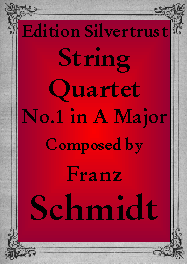Presents
Franz Schmidt
String Quartet No.1 in A Major
 Franz
Schmidt (1874-1939) was born in the Austrian city of Pressburg (now Bratislava)
and began his musical training there. Subsequently, in Vienna, he studied cello
with Franz Hellmesberger and piano with Theodor Leschetizky. At the Vienna
Conservatory, his composition teachers were Robert Fuchs and Anton Bruckner.
Schmidt served as a cellist in the Vienna Court Opera Orchestra (1896-1911) and
played under Mahler. From the First World War until his retirement, he held many
important teaching posts, eventurally serving as the director of theVienna
Staatsakademie as well as Hochschule für Musik.
Franz
Schmidt (1874-1939) was born in the Austrian city of Pressburg (now Bratislava)
and began his musical training there. Subsequently, in Vienna, he studied cello
with Franz Hellmesberger and piano with Theodor Leschetizky. At the Vienna
Conservatory, his composition teachers were Robert Fuchs and Anton Bruckner.
Schmidt served as a cellist in the Vienna Court Opera Orchestra (1896-1911) and
played under Mahler. From the First World War until his retirement, he held many
important teaching posts, eventurally serving as the director of theVienna
Staatsakademie as well as Hochschule für Musik.
Schmidt's roots are to be found in the Viennese Romanticism of his master Bruckner. Although not a prolific composer, he is nonetheless considered the last of the great romantic symphonists. His four chamber music works—2 string quartets, a piano quintet and a quintet for piano, clarinet and string trio--are among his most important.
His First String Quartet dates from 1925. Writing of the work in his Handbook
for String Quartet Players, Wilhelm Altmann remarks that no quartet or chamber
music society should overlook this fine work. From a tonal standpoint, one might
say that it begins where Bruckner’s marvelous string quintet leaves off. Though
clearly rooted in traditional tonality, it nonetheless pushes these boundaries
ever farther. The opening movement, Anmutig bewegt, (graceful, but with
movement) almost sounds as if it begins in mid phrase. The main theme only takes
shape slowly and over a very broad tonal canvas as Schmidt gradually fleshes it out
by way of development. The stunning second movement, Adagio, is clearly
the center of gravity of the quartet. The haunting main theme is first given out
by the cello before it is taken up by the violins. It is calm and with broad
vistas and requires great space to make its affect. Schmidt builds in small
increments quite leisurely. In the powerful middle section, the viola forcefully declaims the
dramatic second theme. Then against the hypnotic pizzicato in the lower voices,
the violins embark upon an extraordinarily beautiful duet. Next comes a scherzo,
Sehr lebhaft. (very lively) It starts in a very Brucknerian vein but
the middle section, which resembles an elves dance because of its harmonics and
high pitched running notes, sounds more like a post-Brucknerian Mendelssohn. The
finale, Ruhig fließend, (quiet but flowing) is a theme and set of several
very original variations. Our sound-bite Presents
but a few.
Unquestionably a masterpiece that belongs in the
concert hall, but because it Presents
no insurmountable technical difficulties, amateurs
will also enjoy this fine work.
Parts: $24.95